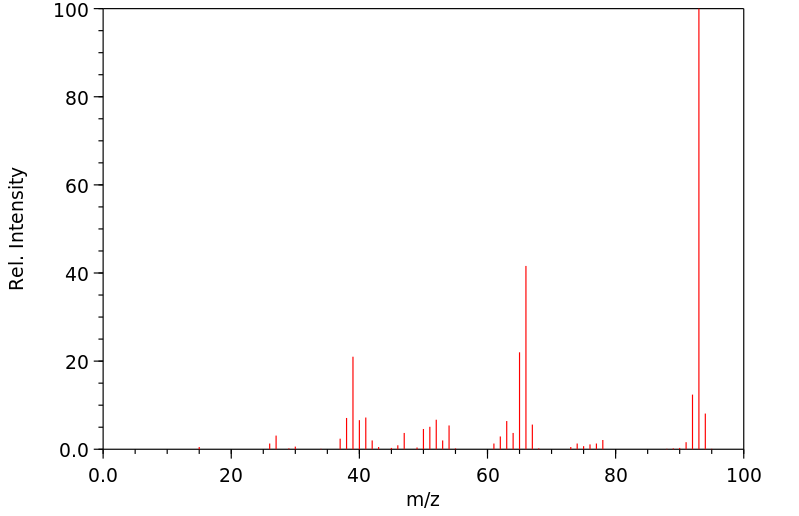二(苯氨基)二甲基硅 | 13435-09-1
中文名称
二(苯氨基)二甲基硅
中文别名
——
英文名称
Bis(anilino)dimethylsilane
英文别名
dianilinodimethylsilane;Dianilino-dimethyl-silan;Silanediamine, 1,1-dimethyl-N,N'-diphenyl-;N-[anilino(dimethyl)silyl]aniline
CAS
13435-09-1
化学式
C14H18N2Si
mdl
——
分子量
242.396
InChiKey
LMBXAKYWWMNNCR-UHFFFAOYSA-N
BEILSTEIN
——
EINECS
——
-
物化性质
-
计算性质
-
ADMET
-
安全信息
-
SDS
-
制备方法与用途
-
上下游信息
-
文献信息
-
表征谱图
-
同类化合物
-
相关功能分类
-
相关结构分类
物化性质
-
熔点:56 °C(Solv: ligroine (8032-32-4))
-
沸点:174 °C(Press: 4-5 Torr)
-
密度:1.077±0.06 g/cm3(Predicted)
计算性质
-
辛醇/水分配系数(LogP):3.91
-
重原子数:17
-
可旋转键数:4
-
环数:2.0
-
sp3杂化的碳原子比例:0.14
-
拓扑面积:24.1
-
氢给体数:2
-
氢受体数:2
安全信息
-
海关编码:2931900090
SDS
反应信息
-
作为反应物:参考文献:名称:对Si-N键,VII。N,N'-烷基化和芳基化的环二硅氮烷的化学作用的贡献†摘要:N,N'-二有机硅烷二胺I可以通过I的双金属化反应,随后与二有机硅二氯化物反应或直接热解而由N,N'-二有机硅烷二胺I制备环二硅氮烷DOI:10.1002/hlca.19640470217
-
作为产物:参考文献:名称:Methylanilinosilanes and Ethylanilinosilanes; Reactions of Anilinosilanes摘要:DOI:10.1021/ja01156a097
文献信息
-
Indirect nuclear spin–spin coupling constants of nitrogen-15 to silicon-29 in silylamines作者:Eriks Kupče、Edvards Liepinš、Olga Pudova、Edmunds LukevicsDOI:10.1039/c39840000581日期:——The 15N–29Si spin–spin coupling constants in silylamines have been measured from 29Si satellites in their natural abundance 15N n.m.r. spectra in an INEPT sequence for accumulation of signals and interpreted in terms of Fermi-contact interaction; the sensitivity of 1J(15N–29Si) to dπ–pπ bonding was noted.
-
Insertion of phenyl isocyanate into mono- and diaminosilanes作者:Konstantin Kraushaar、Marcus Herbig、Dana Schmidt、Jörg Wagler、Uwe Böhme、Edwin KrokeDOI:10.1515/znb-2017-0149日期:2017.11.27sec-butylamino (NHsBu), n-octylamino (NHnOct), n-dodecylamino (NHnDodec), allylamino (NHAll), tert-butylamino (NHtBu), diethylamino (NEt2), and anilino (NHPh) were synthesized and their reactions with phenyl isocyanate were studied. In all cases of these silanes Me3SiNRR′ and Me2Si(NRR′)2 formal insertion of the –NCO group into their Si–N bonds was observed, i.e. formation of products with Si–N (rather than摘要 氨基硅烷 MenSi(NRR')4−n (n=2,3) 与 NRR'=乙氨基 (NHEt)、正丙氨基 (NHnPr)、仲丁氨基 (NHsBu)、正辛氨基 (NHnOct)、n-合成了十二烷基氨基 (NHnDodec)、烯丙基氨基 (NHAll)、叔丁基氨基 (NHtBu)、二乙基氨基 (NEt2) 和苯胺基 (NHPh),并研究了它们与异氰酸苯酯的反应。在所有这些硅烷 Me3SiNRR' 和 Me2Si(NRR')2 的情况下,观察到 -NCO 基团正式插入到它们的 Si-N 键中,即发现形成具有 Si-N(而不是 Si-O)键的产物。在某些情况下,产品可以结晶,其分子结构已通过单晶 X 射线衍射分析阐明。
-
New Diazasilaphosphetidines and their Precursors作者:Bettina Eichhorn、Heinrich NöthDOI:10.1515/znb-2000-0502日期:2000.5.1achieved with LiNHR′ which allows the synthesis of mixed bisaminosilanes (R′HN)(R″HN)SiPh2. The X-ray structures of three of these compounds have been determined. There are no intermolecular N-H···N hydrogen bonds in these compounds in the solid state. Several 1,3,2,4-diazaphosphetidines have been synthesized using bis(N-lithioamino)silanes and bis(N-lithioamino)phosphanes . Amongst these the heterocycle
-
Formation of Aromatic <i>O</i> ‐Silylcarbamates from Aminosilanes and Their Subsequent Thermal Decomposition with Formation of Isocyanates作者:Franziska Gründler、Henrik Scholz、Marcus Herbig、Sandra Schwarzer、Jörg Wagler、Edwin KrokeDOI:10.1002/ejic.202100118日期:2021.6.21(O-silylcarbamates), i. e., compounds with the general motif R1R2N−CO−O−SiR3R4R5 as potential precursors. We focused on the insertion reaction of CO2 into Si−N bonds of substrates with cyclic (mostly aromatic) amine substituents, i. e., PhNHSiMe3, (PhNH)2SiMe2, PhCH2NHSiMe3, p-(MeO)C6H4NHSiMe3, o-C6H4(NHSiMe3)2, 1,2-C6H10(NHSiMe3)2, o-C6H4(NHSiMe3)(CH2NHSiMe3) and 1,8-C10H6(NHSiMe3)2. Compared to previously一种新的无光气制备不同异氰酸酯的途径是从 CO 2和氨基硅烷(参见甲硅烷基胺)开始形成所谓的氨基甲酰氧基硅烷(O-甲硅烷基氨基甲酸酯),即。例如,具有通用基序R 1 R 2 N-CO-O-SiR 3 R 4 R 5作为潜在前体的化合物。我们专注于 CO 2插入具有环状(主要是芳香族)胺取代基的底物的 Si-N 键中的插入反应,即。例如,PhNHSiMe 3、(PhNH) 2 SiMe 2、PhCH 2 NHSiMe 3、p-(MeO)C 6 H 4 NHSiMe 3, oC 6 H 4 (NHSiMe 3 ) 2 , 1,2-C 6 H 10 (NHSiMe 3 ) 2 , oC 6 H 4 (NHSiMe 3 )(CH 2 NHSiMe 3 ) 和 1,8-C 10 H 6 (NHSiMe 3 ) 3)2。与之前研究的氨基硅烷相比,由于 N 原子的亲核性/碱性降低,这些反应受到阻碍。而略有增加的
-
Synthesis and Application of Some Dianilinosilanes, Bis (Trimethylsilyl) Phenylenediamines and Dialkyl Benzo-1,3,2-Diazasilolines as Antioxidants作者:Hussein M. Ali、Mohamed A. M. El-QurashiDOI:10.1080/10426509808545493日期:1998.2.1A number of dialkyl or diphenyl dianilinosilanes, bis (trimethylsilyl) phenylenediamines and dialkyl benzo-1,3,2-diazasilolines were synthesized and used as antioxidants for lubricating base oils. Thermal analysis methods (DSC, TG and DTG) and IR technique were used to follow the oil oxidation. The first peak in the DSC thermograms of oil with the additive antioxidants is the sum of the endothermic
表征谱图
-
氢谱1HNMR
-
质谱MS
-
碳谱13CNMR
-
红外IR
-
拉曼Raman
-
峰位数据
-
峰位匹配
-
表征信息
同类化合物
(βS)-β-氨基-4-(4-羟基苯氧基)-3,5-二碘苯甲丙醇
(S,S)-邻甲苯基-DIPAMP
(S)-(-)-7'-〔4(S)-(苄基)恶唑-2-基]-7-二(3,5-二-叔丁基苯基)膦基-2,2',3,3'-四氢-1,1-螺二氢茚
(S)-盐酸沙丁胺醇
(S)-3-(叔丁基)-4-(2,6-二甲氧基苯基)-2,3-二氢苯并[d][1,3]氧磷杂环戊二烯
(S)-2,2'-双[双(3,5-三氟甲基苯基)膦基]-4,4',6,6'-四甲氧基联苯
(S)-1-[3,5-双(三氟甲基)苯基]-3-[1-(二甲基氨基)-3-甲基丁烷-2-基]硫脲
(R)富马酸托特罗定
(R)-(-)-盐酸尼古地平
(R)-(-)-4,12-双(二苯基膦基)[2.2]对环芳烷(1,5环辛二烯)铑(I)四氟硼酸盐
(R)-(+)-7-双(3,5-二叔丁基苯基)膦基7''-[((6-甲基吡啶-2-基甲基)氨基]-2,2'',3,3''-四氢-1,1''-螺双茚满
(R)-(+)-7-双(3,5-二叔丁基苯基)膦基7''-[(4-叔丁基吡啶-2-基甲基)氨基]-2,2'',3,3''-四氢-1,1''-螺双茚满
(R)-(+)-7-双(3,5-二叔丁基苯基)膦基7''-[(3-甲基吡啶-2-基甲基)氨基]-2,2'',3,3''-四氢-1,1''-螺双茚满
(R)-(+)-4,7-双(3,5-二-叔丁基苯基)膦基-7“-[(吡啶-2-基甲基)氨基]-2,2”,3,3'-四氢1,1'-螺二茚满
(R)-3-(叔丁基)-4-(2,6-二苯氧基苯基)-2,3-二氢苯并[d][1,3]氧杂磷杂环戊烯
(R)-2-[((二苯基膦基)甲基]吡咯烷
(R)-1-[3,5-双(三氟甲基)苯基]-3-[1-(二甲基氨基)-3-甲基丁烷-2-基]硫脲
(N-(4-甲氧基苯基)-N-甲基-3-(1-哌啶基)丙-2-烯酰胺)
(5-溴-2-羟基苯基)-4-氯苯甲酮
(5-溴-2-氯苯基)(4-羟基苯基)甲酮
(5-氧代-3-苯基-2,5-二氢-1,2,3,4-oxatriazol-3-鎓)
(4S,5R)-4-甲基-5-苯基-1,2,3-氧代噻唑烷-2,2-二氧化物-3-羧酸叔丁酯
(4S,4''S)-2,2''-亚环戊基双[4,5-二氢-4-(苯甲基)恶唑]
(4-溴苯基)-[2-氟-4-[6-[甲基(丙-2-烯基)氨基]己氧基]苯基]甲酮
(4-丁氧基苯甲基)三苯基溴化磷
(3aR,8aR)-(-)-4,4,8,8-四(3,5-二甲基苯基)四氢-2,2-二甲基-6-苯基-1,3-二氧戊环[4,5-e]二恶唑磷
(3aR,6aS)-5-氧代六氢环戊基[c]吡咯-2(1H)-羧酸酯
(2Z)-3-[[(4-氯苯基)氨基]-2-氰基丙烯酸乙酯
(2S,3S,5S)-5-(叔丁氧基甲酰氨基)-2-(N-5-噻唑基-甲氧羰基)氨基-1,6-二苯基-3-羟基己烷
(2S,2''S,3S,3''S)-3,3''-二叔丁基-4,4''-双(2,6-二甲氧基苯基)-2,2'',3,3''-四氢-2,2''-联苯并[d][1,3]氧杂磷杂戊环
(2S)-(-)-2-{[[[[3,5-双(氟代甲基)苯基]氨基]硫代甲基]氨基}-N-(二苯基甲基)-N,3,3-三甲基丁酰胺
(2S)-2-[[[[[((1S,2S)-2-氨基环己基]氨基]硫代甲基]氨基]-N-(二苯甲基)-N,3,3-三甲基丁酰胺
(2S)-2-[[[[[[((1R,2R)-2-氨基环己基]氨基]硫代甲基]氨基]-N-(二苯甲基)-N,3,3-三甲基丁酰胺
(2-硝基苯基)磷酸三酰胺
(2,6-二氯苯基)乙酰氯
(2,3-二甲氧基-5-甲基苯基)硼酸
(1S,2S,3S,5S)-5-叠氮基-3-(苯基甲氧基)-2-[(苯基甲氧基)甲基]环戊醇
(1S,2S,3R,5R)-2-(苄氧基)甲基-6-氧杂双环[3.1.0]己-3-醇
(1-(4-氟苯基)环丙基)甲胺盐酸盐
(1-(3-溴苯基)环丁基)甲胺盐酸盐
(1-(2-氯苯基)环丁基)甲胺盐酸盐
(1-(2-氟苯基)环丙基)甲胺盐酸盐
(1-(2,6-二氟苯基)环丙基)甲胺盐酸盐
(-)-去甲基西布曲明
龙蒿油
龙胆酸钠
龙胆酸叔丁酯
龙胆酸
龙胆紫-d6
龙胆紫







